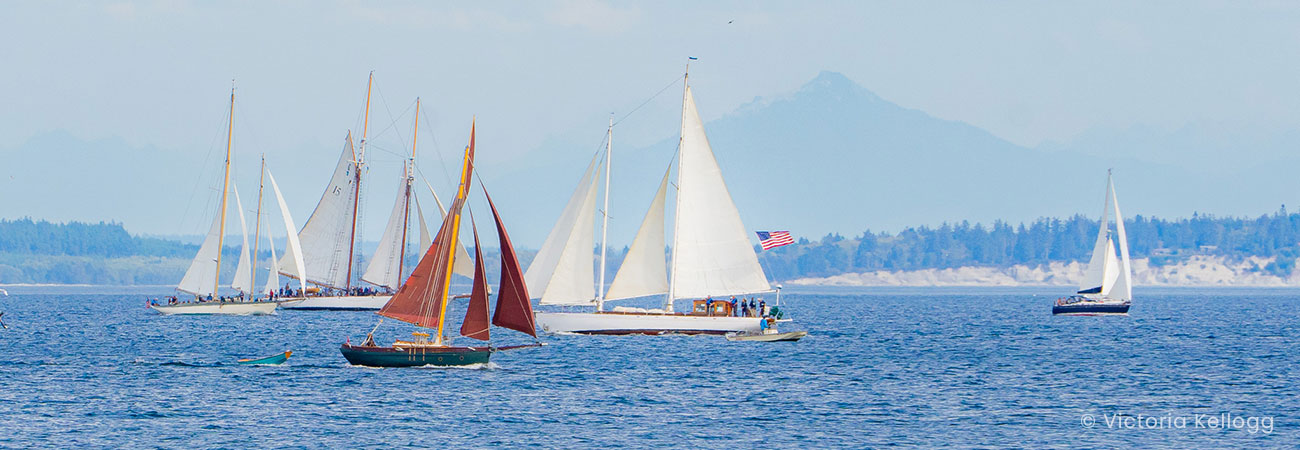See who’s coming in 2024!
If you have been accepted and do not see your boat below, please check back, as new boats are added all the time. We strive to have all accepted boats listed below by August 1
-
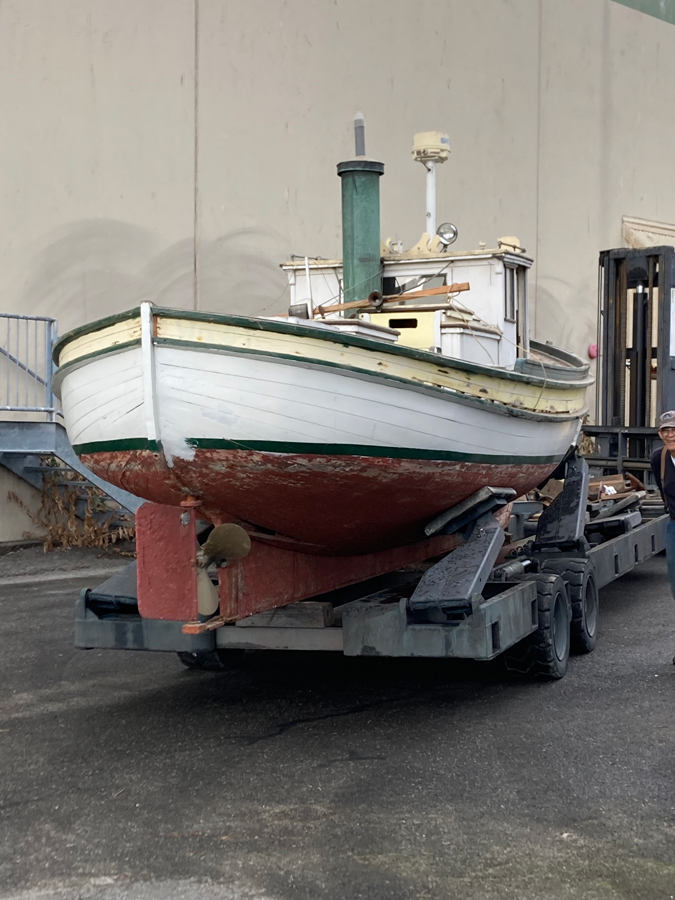 AbishagHome Port: Anacortes, WAYear Built: 1970LOA: 28'8"Beam: 8'Owner: Emerald Marine CarpentryDesigner: Edmund Lincoln DevereauxDesign: Monterey TypeType: Power
AbishagHome Port: Anacortes, WAYear Built: 1970LOA: 28'8"Beam: 8'Owner: Emerald Marine CarpentryDesigner: Edmund Lincoln DevereauxDesign: Monterey TypeType: PowerAbishag was built by Edmund Lincoln Devreaux in Vallejo California and launched in 1970.
Lincoln was a retired shipwright from Bear Island, US Navy Yard.She is a modeled from a Monterey boat, but has no clipper bow, which the usual form. Her straight stem is better for punching through the short chop in the north SF bay, and some Montereys have historically been built in a similar manner.
Abishag has bent oak frames, yellow cedar planking, and a fir and teak deck. She is fastened with galvanized nails and bronze screws.
Lincoln also moved the deck houses together. This made more deck space and better placement for the single cylinder Hicks make-and-break engine, which has alway been her engine. The Yuba Hicks engines, from Sausalito, Ca. were among the most popular and dependable engines on the West Coast, when they were built in the 1920’s. Abishag’s was an early Hicks, from 1912: 8-11 HP, 6.5 “ bore. 7.5” stroke, 244 c.i. cylinder bore, 360 rpm @ hull speed, 6 knots. Gasoline fuel consumption at hull speed: 3 quarts/ hour.
Abishag was fit out to fish and did, for a season, before she was trucked to Anacortes.
In the late 80’s, with the builder’s passing, she was sold to John Anderson in Bellingham.
She cruised and fished the Salish Sea until John’s passing, when she was laid up, for sale at Colony Wharf, Bellingham.Elton H., who was the boat’s original engineer and installed the Hicks, suggested that Emerald Marine partner with him and save the vessel. Free boats not with standing, work begun in fall of 2022. Together we have: moved the vessel back to Anacortes, replaced the the after stem and a significant amount of the after planking and the garboard strakes, rebuilt the steering fittings, removed and rebuilt the Hicks, installed new tanks and wiring, and more.
We look forward to fishing, cruising and teaching about old engines and shipwrighting as we go along…
-
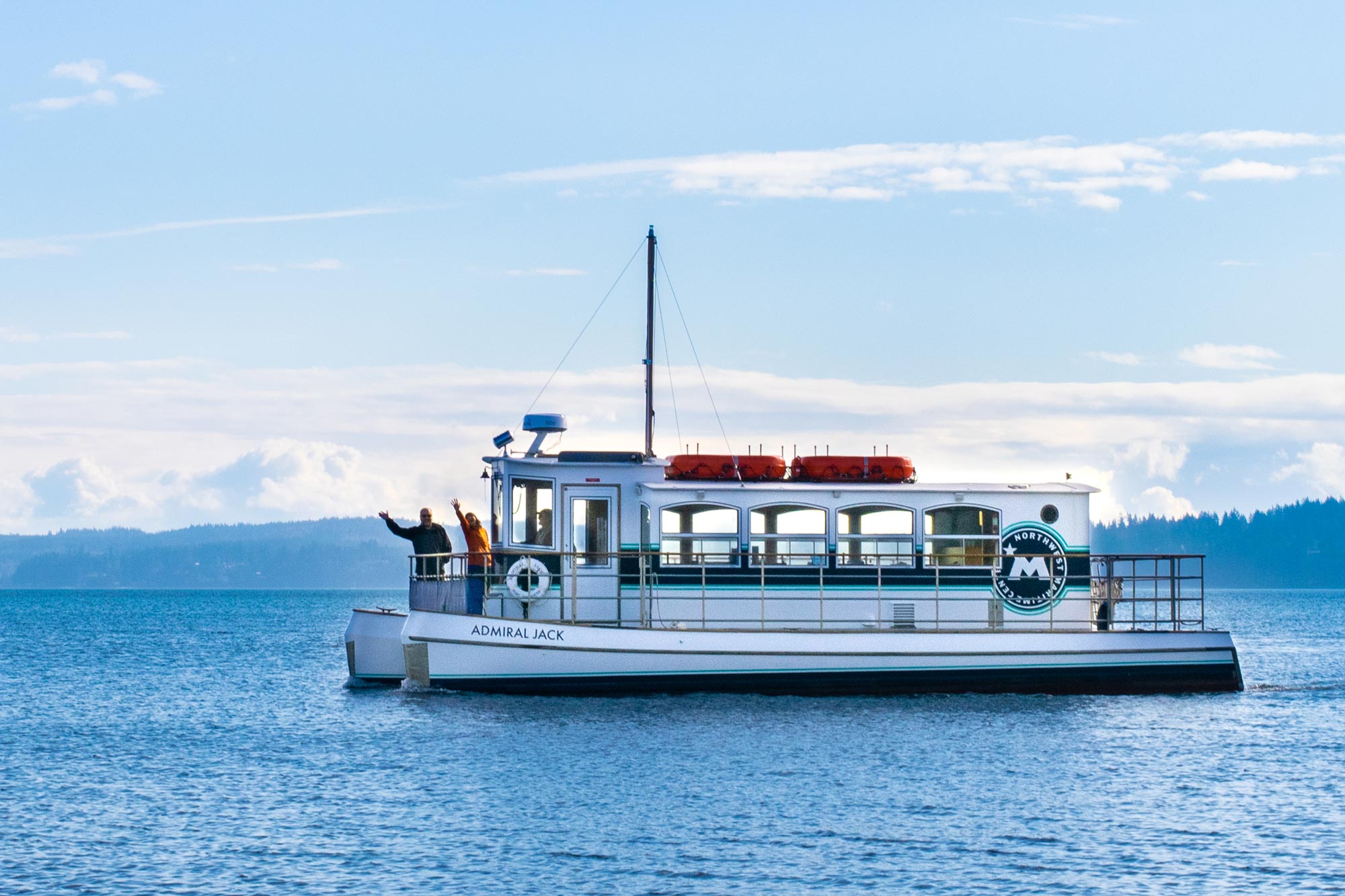 Admiral JackHome Port: Port Townsend, WAYear Built: 1992LOA: 39'7"Beam: 15'6"Owner: Northwest MaritimeDesigner: Sam DevlinDesign: Devlin CatamaranType: Power
Admiral JackHome Port: Port Townsend, WAYear Built: 1992LOA: 39'7"Beam: 15'6"Owner: Northwest MaritimeDesigner: Sam DevlinDesign: Devlin CatamaranType: PowerAdmiral Jack is the newest addition to Northwest Maritime’s fleet! A comfortable tour boat in the summer and a state-of-the-art floating classroom during the school year.
-
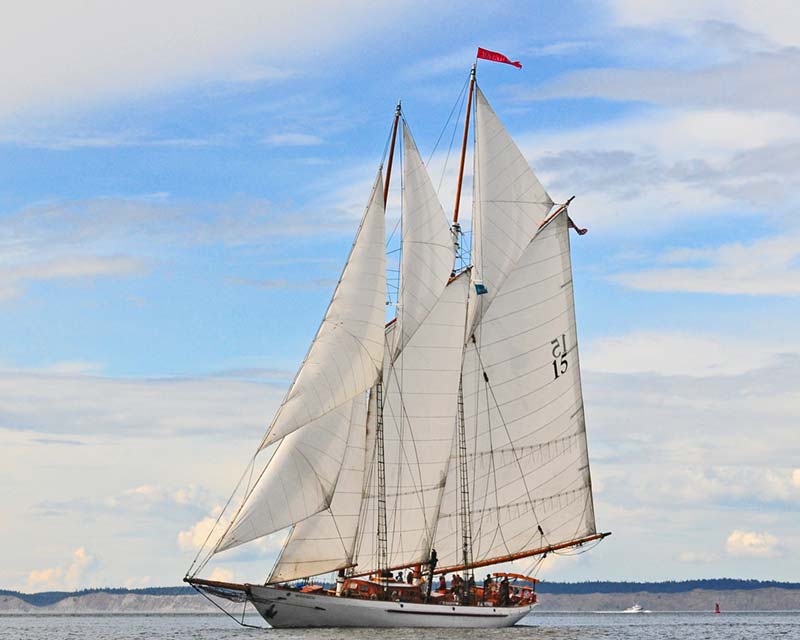 AdventuressHome Port: Port Townsend, WAYear Built: 1913LOA: 131Beam: 21Owner: Schooner Adventuress Sound ExperienceDesigner: B.B. CrowninshieldDesign: One-offType: Schooner
AdventuressHome Port: Port Townsend, WAYear Built: 1913LOA: 131Beam: 21Owner: Schooner Adventuress Sound ExperienceDesigner: B.B. CrowninshieldDesign: One-offType: SchoonerSound Experience sails the historic schooner Adventuress to educate, inspire, and empower an inclusive community that works to improve our marine environment and celebrates our maritime heritage. Since her launch in E. Boothbay, Maine, in 1913, the B.B. Crowninshield-designed schooner has traveled the Strait of Magellan and the Bering Sea on an arctic expedition for naturalist Roy Chapman Andrews; served as a Bar Pilot vessel off of San Francisco; patrolled the west coast during World War II; and trained young sailors in seamanship skills in Seattle with Youth Adventure. Adventuress has sailed on the waters of Puget Sound for almost three decades under the stewardship of nonprofit Sound Experience, offering hands-on environmental education and leadership development to thousands of young people annually and partnering with youth-serving organizations to reach at-risk kids. Sound Experience offers programs for all ages and backgrounds and takes pride in providing many levels of training opportunities for volunteer and paid crew. Adventuress is a National Historic Landmark officially recognized as “Puget Sound’s Environmental Tall Ship.”
-
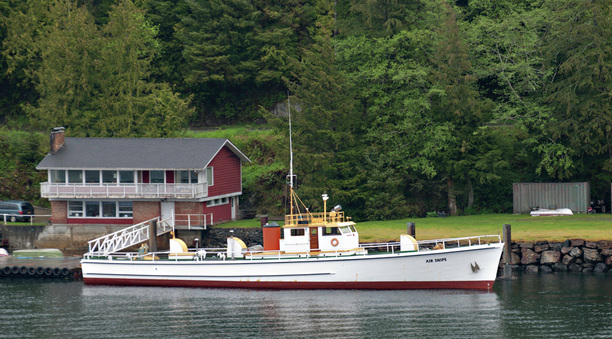 Air SnipeHome Port: Ketchikan, AKYear Built: 1943LOA: 110' 10"Beam: 17' 11"Owner: Matt LevyDesigner: US NavyDesign: SC-497 ClassType: Subchaser
Air SnipeHome Port: Ketchikan, AKYear Built: 1943LOA: 110' 10"Beam: 17' 11"Owner: Matt LevyDesigner: US NavyDesign: SC-497 ClassType: SubchaserThe Air Snipe (ex SC-1068) was laid down Dec 10th of 1942 as PC-1068 in Camden NJ by Mathis Yacht Building Company (later became John Trumpy & Sons); she was completed March 26th, 1943 and then reclassified and commissioned into the USN on April 13th, 1943 as SC-1068.
All told a series of small shipyards built 438 examples of this design, the SC-497 class subchaser : out of the 438 vessels of this type it is believed that less than 5 are currently still afloat! They were armed with a variety of ordnance, but the most common arrangement fielded a set of two mousetrap anti submarine projectors (four 37lb torpex filed rockets each), a forward gun (40mm Bofors, 3″-50 cal or 3″-23 cal), three 20mm Oerlikon auto cannons aft of the house, two K-gun depth charge launchers, and various roll off depth charge racks (Some smaller 30 cal and 50 cal machine guns have been reported as field fitted as well).
She served in the South Pacific during WWII conducting anti submarine patrols and assisting with convoy escort and screening of surface ships. The role of the Subchasers was expanded during this time to support numerous amphibious landings, provide offshore screening, and landing craft / beach control. After her time in the tropics, she was returned to the US mainland where she was decommissioned and transferred to the USCG on Feb 26th 1946 as an Air Class Rescue Cutter (WAVR).
The USCG used 70 of these vessels to perform search and rescue work as well as general “plane guard” for the large numbers of cargo planes and vessels returning home from overseas after WWII. Then on the 27th of Jan 1948 she was declared surplus and sold to a private owner.
After passing through three initial owners she came under the care of Albert Halvorsen on Sept 25th 1958, she was officially transferred into the Boyer Towing Fleet on May 13th 1959. Where she provided barge and freight service to Southeast Alaska. Becoming one of the very first vessels to establish barge service to Ketchikan, AK from Seattle, WA.
After living the life of a working tug for a number of years she was replaced in the fleet with larger and more modern ocean going tugs, however, she had gained a champion in her time as a civilian work boat. Kent Halvorsen became her biggest advocate and continued to care for the Air Snipe as she shifted roles from work boat to company “yacht”.
Keeping up on the maintenance and making repairs as the vessel aged; Kent oversaw the preservation and restoration of the Air Snipe for over half a century. In this time the Air Snipe became a fixture in Ward Cove and Ketchikan, AK; unfortunately as time marches on, Kent ended up having to spend less and less time on the vessel until his health finally prevented him from stepping on-board any longer. Kent’s son Pete had taken over the mantle of caretaker for much of this time as it became more difficult for Kent to fully care for the Air Snipe. Finally in Nov. of 2023 Kent ended up passing.
This left Boyer Halverson, namesake of Boyer towing with a dilemma; the Air Snipe needed someone that would keep her active and be able to maintain and care for the vessel. The thought of vetting new owners and finding the right fit seemed impossible. Through a series of happenstance Matt Levy & Kelly Thynes, who were actively involved in restoring the 1943 WWII 83ft USCG Cutter USCG-11 (83366) (which was a rescue boat off Omaha Beach during the D-Day Landings) were connected with the Halvorsens through mutual friends in Ketchikan, and after some discussion a plan was formed.
The Air Snipe was to head south again to allow the general public to explore and experience a very rare piece of WWII history which has also created it’s own Southeast Alaskan legacy after the war. As a tribute to Kent Halvorsen and all the hard working employees at Boyer Towing, who have preserved and expanded the legacy of the Air Snipe there is no better way to say thank you than to continue the work and share her story.
-
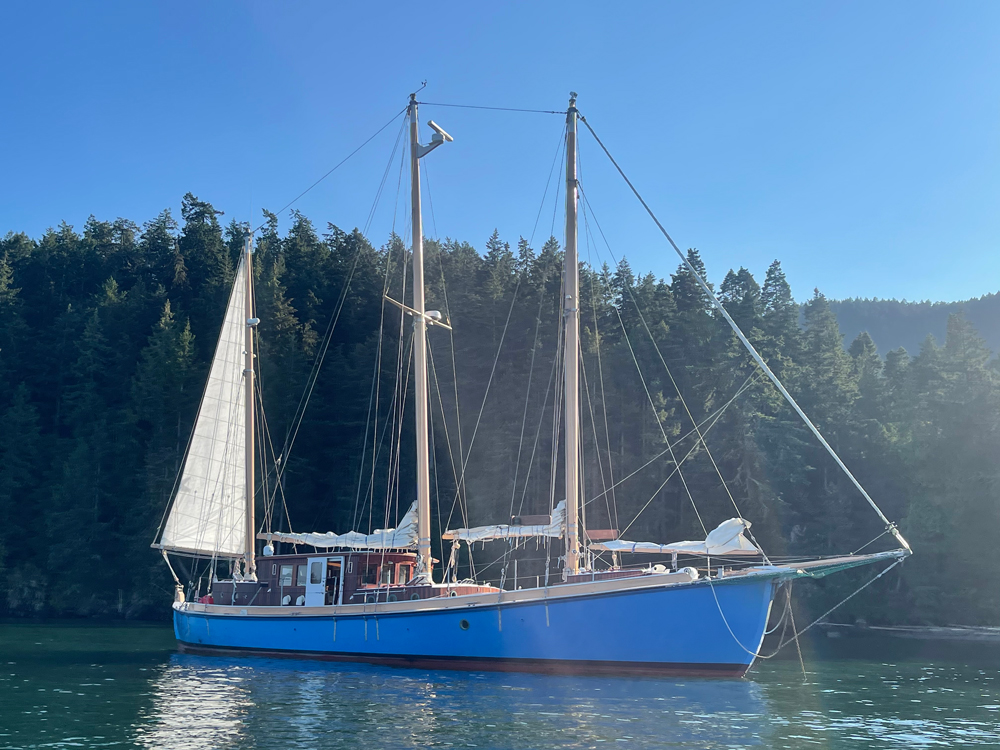 Alca iHome Port: San Juan Islands, WAYear Built: 2003LOA: 64'1"Beam: 17'Owner: Mark BaxterDesigner: George BuehlerDesign: Alca iType: Schooner
Alca iHome Port: San Juan Islands, WAYear Built: 2003LOA: 64'1"Beam: 17'Owner: Mark BaxterDesigner: George BuehlerDesign: Alca iType: SchoonerAlca i was inspired by Colin Archer and designed by George Buehler (from Whidbey Island). She was constructed in 2003 to subarctic exploration vessel standards with 2″ thick oak plank on frame construction and then encapsulated with two to four layers of fiberglass/epoxy resin for the purpose of conducting research in the Northwest Atlantic on behalf of the Smithsonian Institution. Alca i is equipped with seven water-tight bulkheads and six water-tight doors as well as redundant tankage, electrical, hydraulic and navigational systems to provide added safety and security for operating in remote, harsh environments. Upgrades by her current owner include roller-reefing jib, roller-reefing main stays’l, extensive LED lighting throughout, nine additional hatches for enhanced light and ventilation, 1,800 watts of solar cells, modification of pilothouse roof for water catchment, Wallace diesel range top and oven, dual voltage refrigerator/freezers with drawers, installation of cameras for enhanced visibility in front of the bow, remote-controlled anchor windlass, remote-controlled autopilot, Airhead composting toilet and two wood-burning Navigator stoves for onboard comfort over the winter months.
-
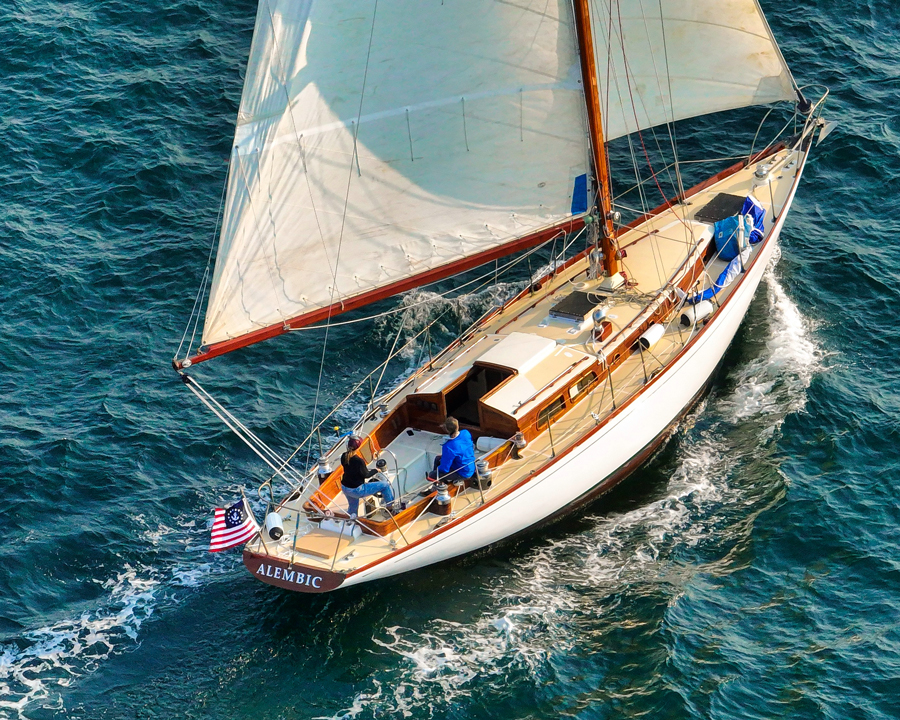 ALEMBICHome Port: Port Townsend, WAYear Built: 1960LOA: 48'Beam: 11'6"Owner: Steven TodorovDesigner: Sparkman & StephensDesign: One-offType: Sloop
ALEMBICHome Port: Port Townsend, WAYear Built: 1960LOA: 48'Beam: 11'6"Owner: Steven TodorovDesigner: Sparkman & StephensDesign: One-offType: SloopSparkman and Stephens designed the 48’ auxiliary cutter ALEMBIC to give her maximum windward ability (design #1479). Built by Chapman and Kalayjian, in Costa Mesa, CA, she was launched at Newport Beach in 1960, for the original owner, Dr. Gordon Alles.
Construction is mahogany, strip planked, over white oak frames. The box-beam mast is Sitka spruce and the boom Douglas Fir. Original trim is Honduras mahogany, much of which has been replaced with Sapele. She is bronze fastened and has bronze floors atop the deadwood. Decks are fiberglass covered ⅝” plywood. Below deck, ALEMBIC has been repowered with a Westerbeke 62 hp diesel and she carries 60 gallons of fuel and 140 gallons of water in monel tanks. Pulpit, pushpit and stanchions are all monel on bronze bases.
She has accommodations for seven, with two in the owner’s stateroom forward, and full berths for five guests. In the galley, which is situated aft on the portside, there is a propane stove with an oven, and an ice box. The light build, simple interior and expansive sail lockers are indicative of the owner’s focus on ocean racing. Dr. Alles, a research chemist, named the vessel for the ancient tools of alchemists called Alembics. These were used to derive the essences of perfumes from flowers or spirits from wines. Similarly, ALEMBIC will serve to distill the essence of sailing for all those aboard.
-
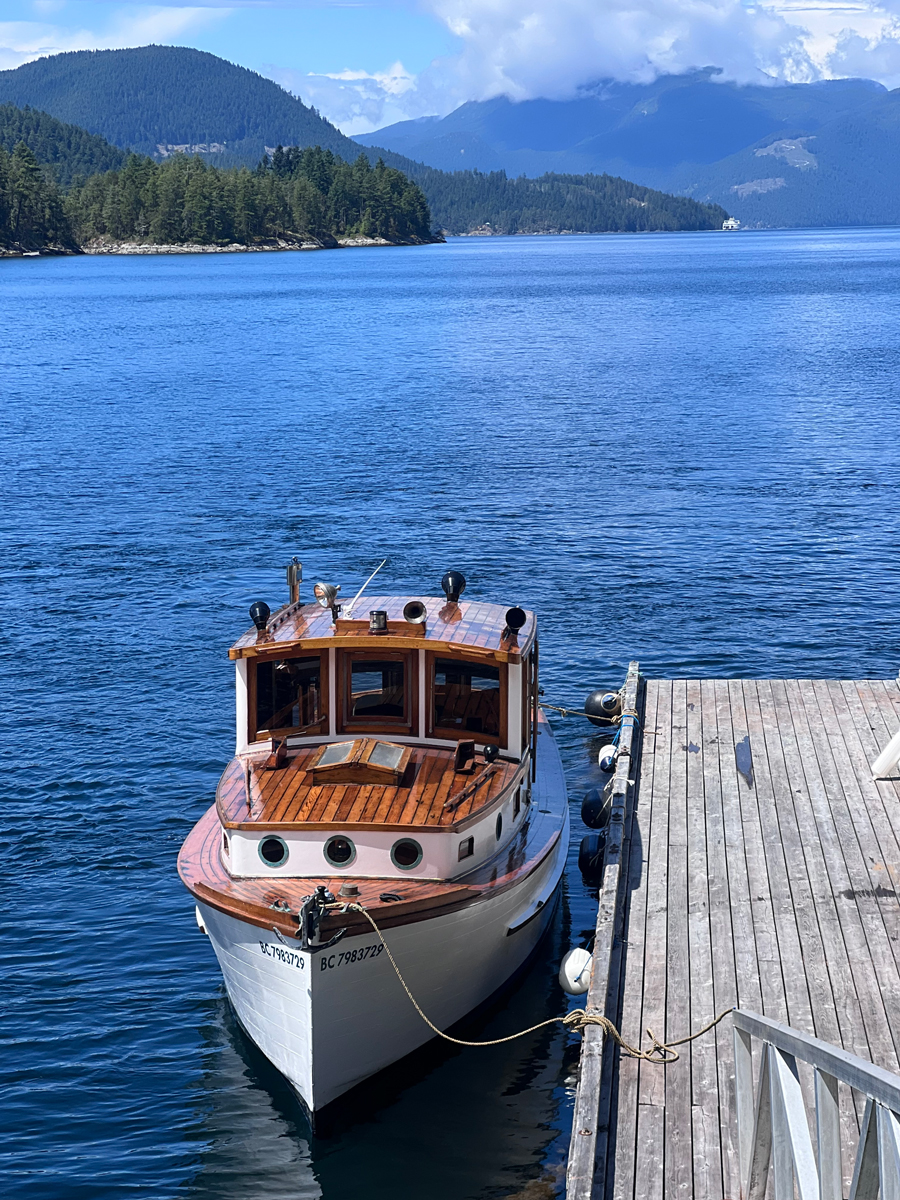 AnandaFor SaleHome Port: Egmont, BCYear Built: 1932LOA: 32'Beam: 9'Owner: Charlie SyburgDesigner: Peter HansenDesign: Tri Cabin CruiserType: Power
AnandaFor SaleHome Port: Egmont, BCYear Built: 1932LOA: 32'Beam: 9'Owner: Charlie SyburgDesigner: Peter HansenDesign: Tri Cabin CruiserType: PowerAnanda is a 32’ Tri cabin cruiser built by Peter Hansen in Everett, Wa and launched in 1932. Ananda was built and designed by Peter Hansen for his personal use and was originally named the Margaret H (One account states she was named for his wife and another his grand daughter). Upon completion in his yard, Ananda was rolled on logs downhill to the launch site. She is currently moored in Egmont, BC and cruises extensively each season in the waters of BC… with regular trips to Princess Louisa inlet, Desolation Sound and the gulf islands.
-
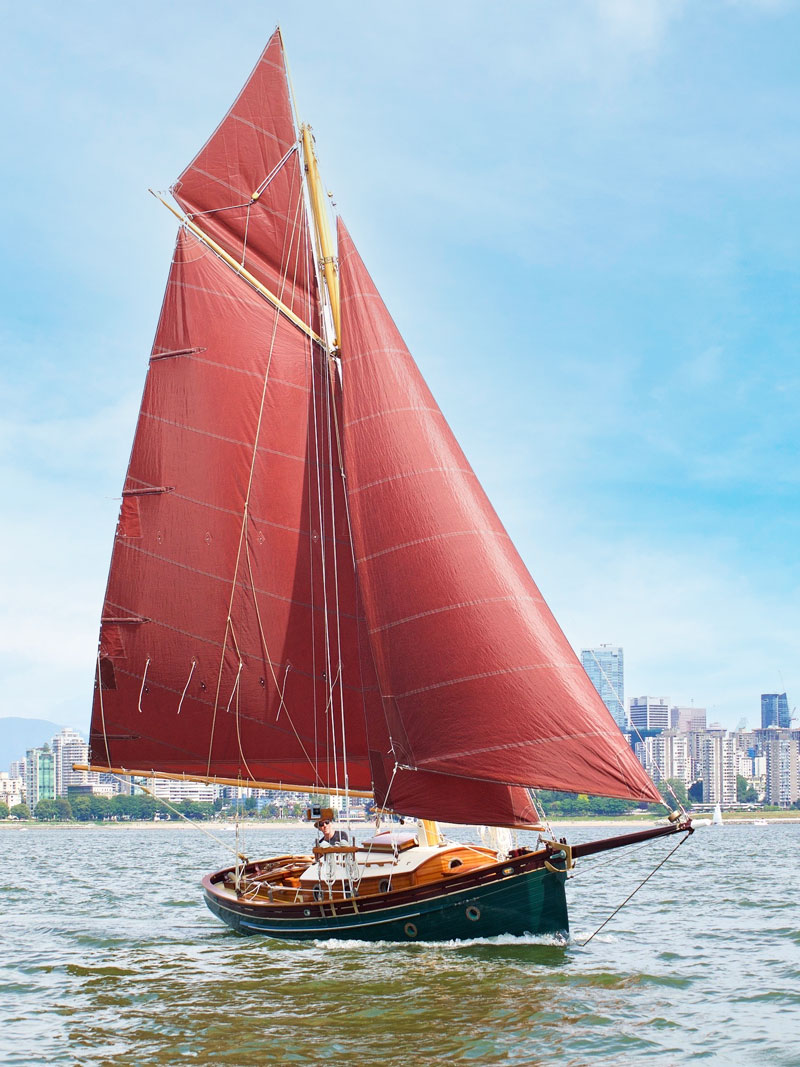 ANJAHome Port: Vancovuer, BCYear Built: 2014LOA: 32'Beam: 8'6"Owner: Arnt ArntzenDesigner: Roger LongDesign: 23' CutterType: Gaff Rigged Cutter
ANJAHome Port: Vancovuer, BCYear Built: 2014LOA: 32'Beam: 8'6"Owner: Arnt ArntzenDesigner: Roger LongDesign: 23' CutterType: Gaff Rigged CutterANJA is based on a gaff rigged Bristol pilot cutter designed by Roger Long in 1976. Launched in 2014 on Saltspring Island, BC. Hull built by David Betts and the cabin, rig and interior built by Arnt Arntzen in 2020.
ANJA is the cover girl on Wooden Boat Magazine Jan/Feb 2023 with a fabulous article by Larry Cheek and photos by Dale Simonson and co-owner Valerie Arntzen. She won Best Pocket Cruiser in Victoria Classic Boat Festival 2023.Her hull is constructed of mahogany planks on oak frames fastened with bronze screws. Mast is hollow bird’s mouth Sitka spruce. Much of the hardware is made from recycled bronze. Cockpit seats are recycled old growth fir church pews.
She is powered by a brand new Beta Marine diesel 20 horse with new 14” auto prop. There is a two burner propane stove, ice box, plenty of storage and a large double berth for comfortable cruising.ANJA has cruised the west coast as far north as Alert Bay and Broken Islands on the west coast of Vancouver Island.
She is exciting to sail with plenty of strings to pull with 4 sails including the topsail which sets over 500 square feet -
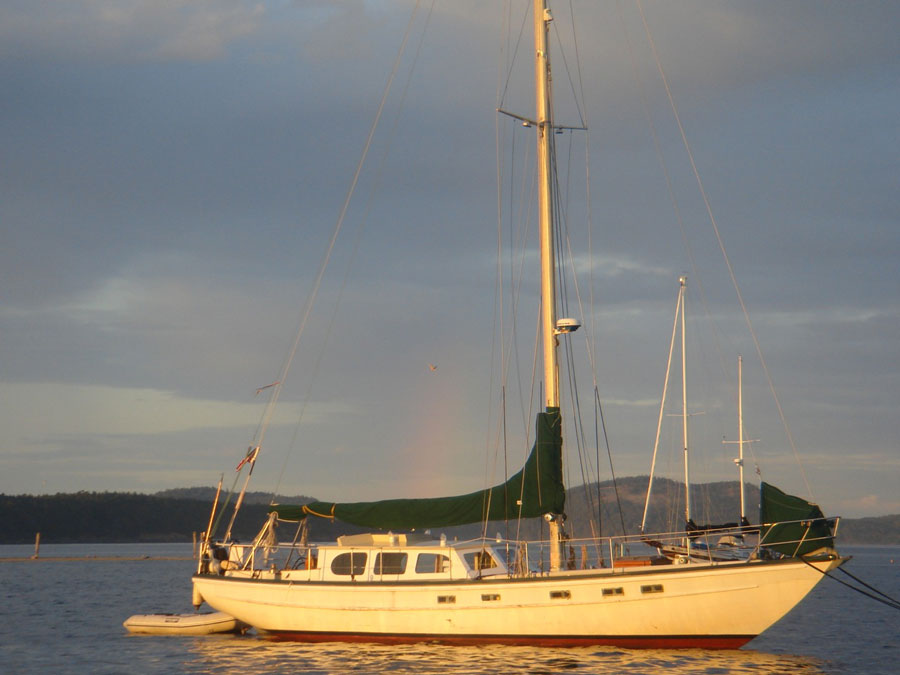 AnnaHome Port: Seattle, WAYear Built: 1965LOA: 47'Beam: 12'6"Owner: Scott AndrewsDesigner: AldenDesign: Lady Halene 47Type: Sloop
AnnaHome Port: Seattle, WAYear Built: 1965LOA: 47'Beam: 12'6"Owner: Scott AndrewsDesigner: AldenDesign: Lady Halene 47Type: SloopAnna was built in 1966 in Picton New Zealand. One of her sister boats is detailed in XXXX The Proper Yacht. When we purchased the boat there were a number of stories which were told about her. She was sailed for 10 years in the South Pacific, sailed around Cape Horn at least twice. Was home ported in SE Alaska before being seized by the IRS. In the early 2000 she was purchased by the current caretakers in 2001. She has been a live aboard and a family vacation boat.
Upgrades include new decks in 2007 and new sails in 2020. Over the current caretakers time, electrical, plumbing, and much around the engine has been renewed.
-
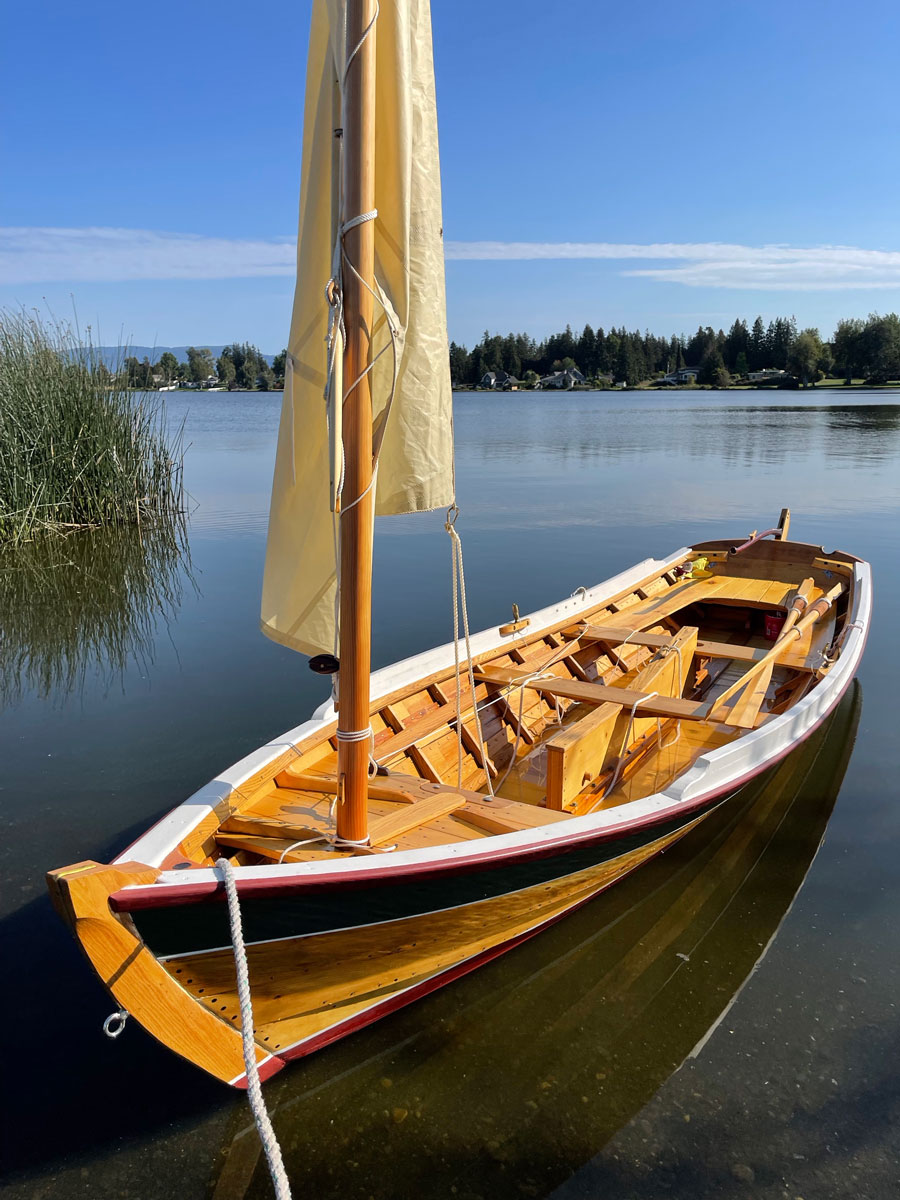 Anna BrayHome Port: Blaine, WAYear Built: 2021LOA: 18'Owner: Mia AndrewDesigner: John BDesign: Culler sailboatType: Culler
Anna BrayHome Port: Blaine, WAYear Built: 2021LOA: 18'Owner: Mia AndrewDesigner: John BDesign: Culler sailboatType: CullerAnne Bray is the “little sister” to Serenity – the 22ft skiff used for fishing, crabbing and traveling to the islands. Built by John Breiby in Wasilla, AK, this two masted sprit sail boat has great amenities such as being made from Alaska Sitka Spruce with Purple Heart blocks, the rudder is hung with the English beach boat system and will kick up if it strikes something. The masts and Sprit rigging is adjustable for all types of sailing conditions, or if your just want to go for the plain fun of rowing!!!
Pete Culler designed 2 skiffs- one for Maynard Bray, and this one for his wife Anne, who unfortunately passed away before she had the chance to this little beauty. Which is the reason why I honor my boat with her name.
-
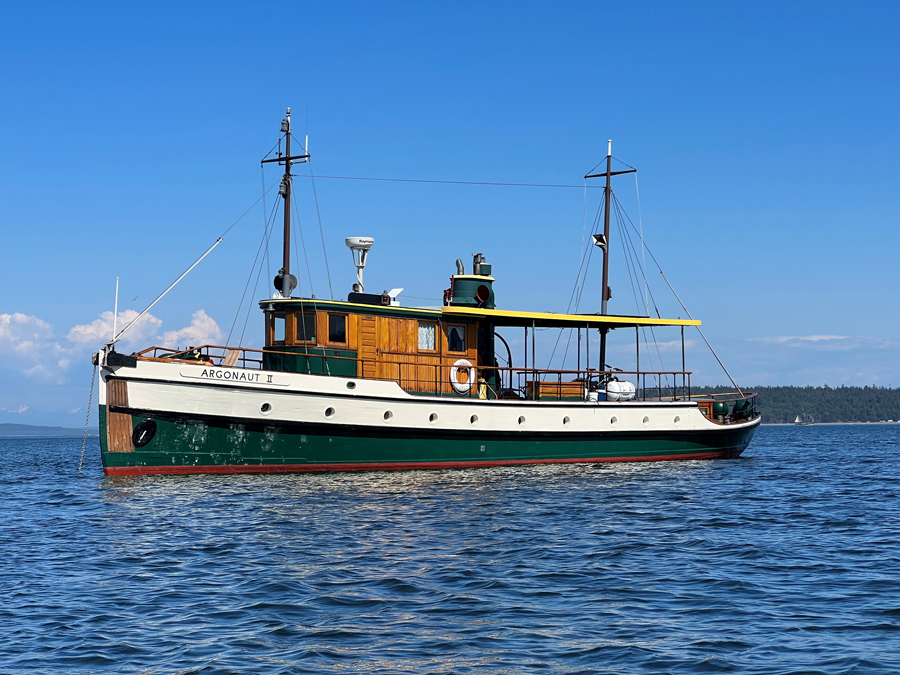 Argonaut IIFor SaleHome Port: Seattle, WAYear Built: 1922LOA: 73'3"Beam: 14'8"Owner: Nicholas VerrochiDesigner: Menchions ShipyardDesign: One-offType: Power
Argonaut IIFor SaleHome Port: Seattle, WAYear Built: 1922LOA: 73'3"Beam: 14'8"Owner: Nicholas VerrochiDesigner: Menchions ShipyardDesign: One-offType: PowerFor more than a century, Argonaut II sailed the waters of the Pacific Northwest and most famously served the remote native tribes and rural communities of British Columbia. Originally built as a corporate yacht for the Powell River Company in Vancouver, BC in 1922, the United Methodist Church purchased the boat in 1934 to serve as a Mission Boat until 1967. Originally named “Greta M,” the church rechristened the boat “Thomas Crosby IV” after a NW Missionary, and skippered by the famous Haida Chief Rev. Dr. Peter Kelly who was the first full-blooded Native American ordained in the United Church of Canada. Thomas Crosby IV operated as a fully-equipped hospital, servicing the remote lighthouses, canneries, logging camps, and isolated settlements, and carried more than 1000 patients a year. In 1967, the boat was renamed “Argonaut II” and has been a private yacht ever since, thankfully with many willing hands to continue its maintenance and upkeep.
Argonaut II was originally powered by a 3-cylinder Fairbanks Morse engine, but repowered in 1940 with an air-start 6-cylinder Gardner 6L3. The carvel-planked hull is made of 2 1/2″ Port Orford Cedar (and we are currently pulling original wood off the boat still in decent condition for its age). In 2023, local Port Townsend Shipwrights Peter Stein, Quillan Hunt, and Rowan Schatz supported a ten-week project replacing 37 Alaskan yellow cedar planks, 21 white oak frames, inner and outer sponson and purpleheart/ironbark guard on the Starboard side, as well as some modifications to the rudder and interior systems. The deck is made of fir, with a teak pilot house and teak railings. Below deck, the boat feels like a step back in time, maintained as it was during its times serving as a mission boat, with stained glass cabinets in the main salon, an aft state room with two bunks, and a forward stateroom ahead of the engine room.
Follow the ongoing projects, story, and adventure on YouTube and Instagram at mv_argonaut@
-
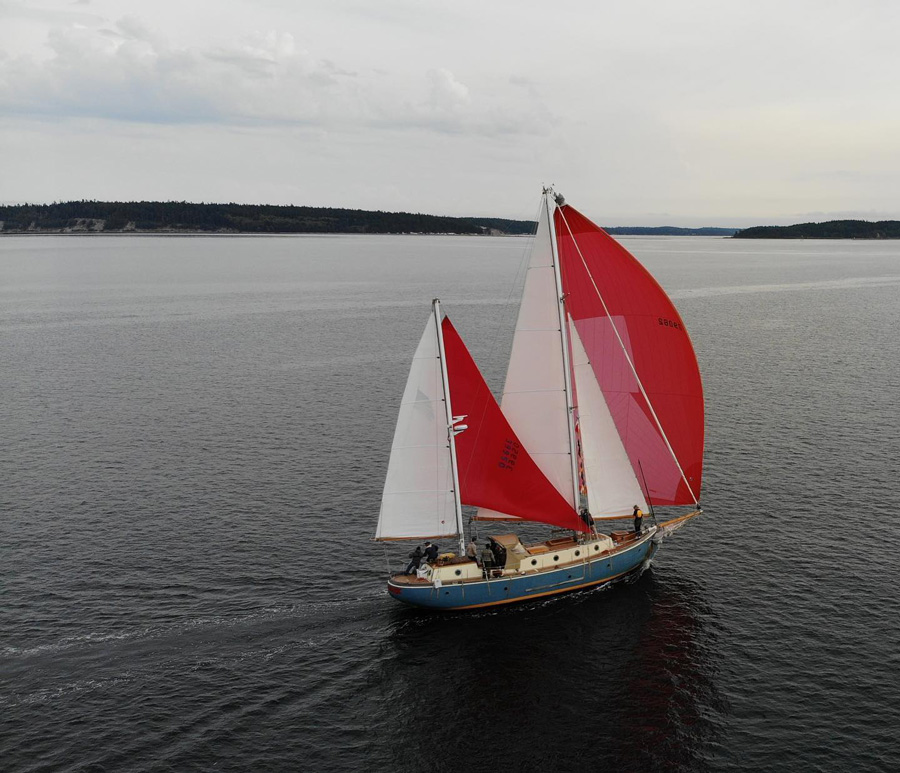 Ariel of VictoriaHome Port: Anacortes, WAYear Built: 1980LOA: 58'Beam: 13'6"Owner: Christine GranquistDesigner: Fred PetersonDesign: One-offType: Ketch
Ariel of VictoriaHome Port: Anacortes, WAYear Built: 1980LOA: 58'Beam: 13'6"Owner: Christine GranquistDesigner: Fred PetersonDesign: One-offType: KetchCarvel-planked in Alaskan yellow cedar on oak frames, Ariel of Victoria was built by Fred Peterson and Ron Hunt in Peterson’s shipyard near Nanaimo. Her ketch rig features original sitka spruce masts & booms. She has been a liveaboard vessel since launch and cruised extensively. Her current owners are 15 years into a major restoration and systems upgrade, pausing regularly to go sailing.
-
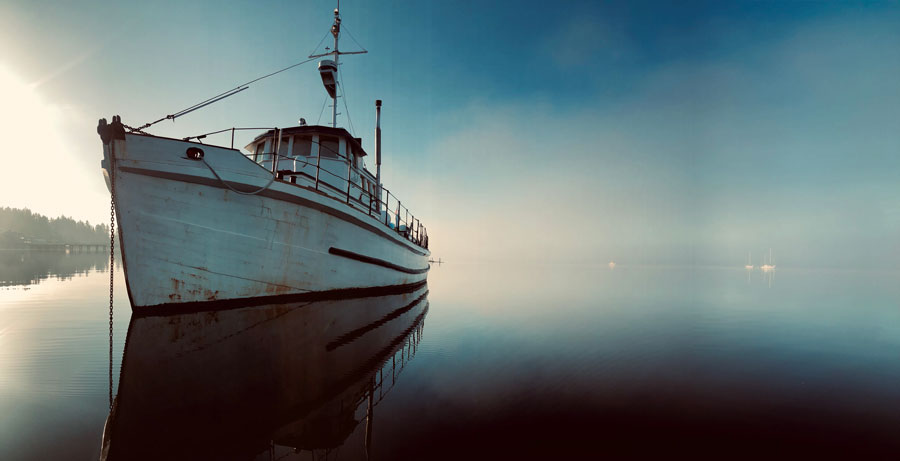 BadgerHome Port: Port Townsend, WAYear Built: 1955LOA: 75'Beam: 19'Owner: Douglas LudwigDesigner: UnknownDesign: YAGType: Power
BadgerHome Port: Port Townsend, WAYear Built: 1955LOA: 75'Beam: 19'Owner: Douglas LudwigDesigner: UnknownDesign: YAGType: PowerBadger (YAG-319) was one of ten wooden YAG-300 (Yard Auxiliary, General) vessels built for the Royal Canadian Navy (RCN) between 1953 and 1955. Built for use as auxiliary craft, Badger primarily served as an at-sea training platform for junior naval officers, boatswains, reserve personnel and Sea Cadets at Canadian Forces Base Esquimalt.
-
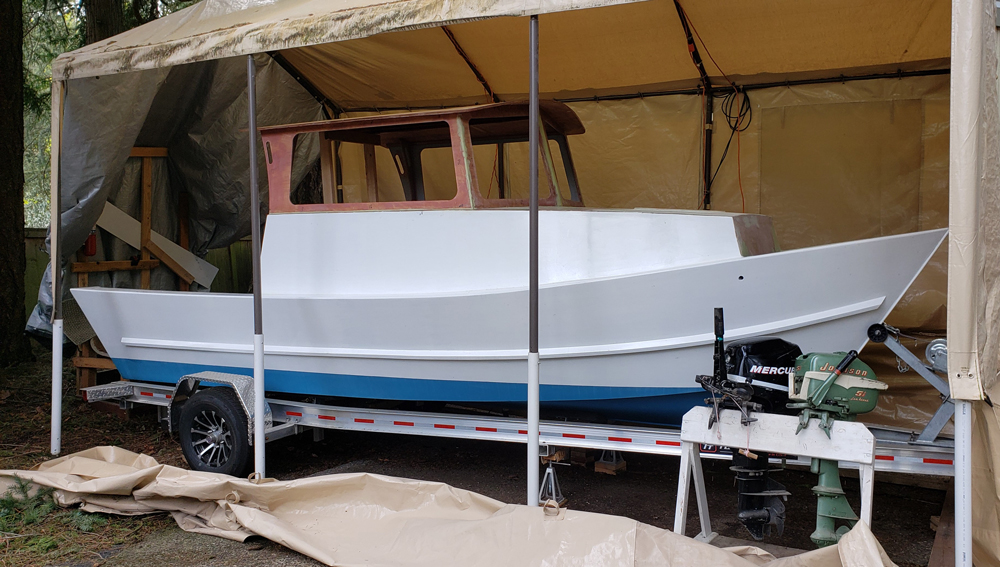 Be HappyHome Port: Lake Oswego, ORYear Built: 2024LOA: 23'Beam: 7'6"Owner: Randal TorgersonDesigner: Renn TolmanDesign: PowerType: Tolman Widebody Skiff
Be HappyHome Port: Lake Oswego, ORYear Built: 2024LOA: 23'Beam: 7'6"Owner: Randal TorgersonDesigner: Renn TolmanDesign: PowerType: Tolman Widebody SkiffBE HAPPY is a 21 foot Tolman Widebody Skiff built for fishing and overnight cruising. Built from marine plywood and encapsulated in epoxy and fiberglass she took a little more than 5 years to build. Covid slowed the build process and then there was being locked out of the shop space because the building was unsafe. BE HAPPY was finally move to my driveway where the build was completed.
-
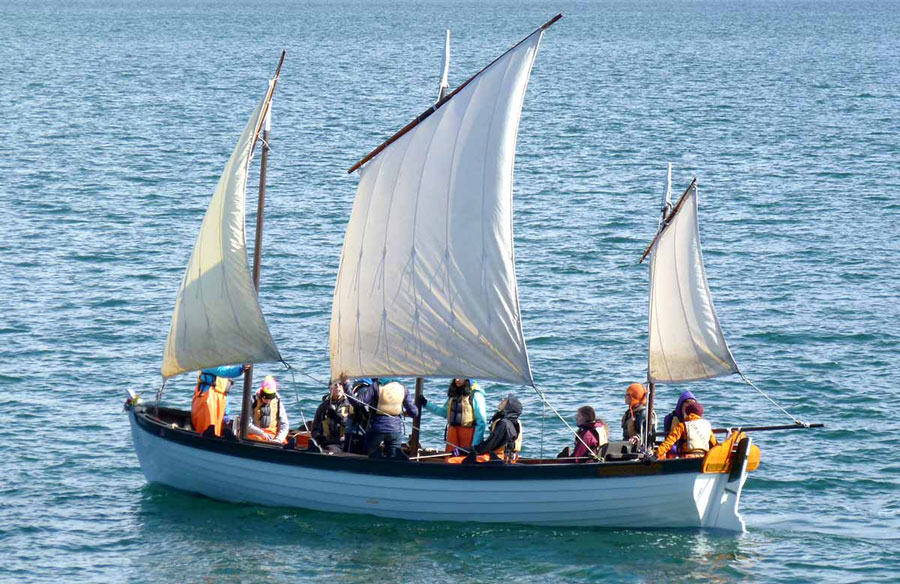 BearHome Port: Port Townsend, WAYear Built: UnknownLOA: 26'Beam: 6'Owner: Northwest MaritimeDesigner: UnknownDesign: Oceanic DoryType: Row
BearHome Port: Port Townsend, WAYear Built: UnknownLOA: 26'Beam: 6'Owner: Northwest MaritimeDesigner: UnknownDesign: Oceanic DoryType: RowCommissioned by the Wooden Boat Foundation, Bear was built in partnership with Gray Wolf Ranch and the NW School of Wooden Boatbuilding. Greg Foster designed her from the lines of Pacific Crest Outward Bound’s Elizabeth Bonaventure. She’s been used for a wide variety of on-the-water programs including Sea Scouts, Adventures at Sea and Puget Sound Explorers. She’s made a wonderful companion-ship to the Townshend.
-
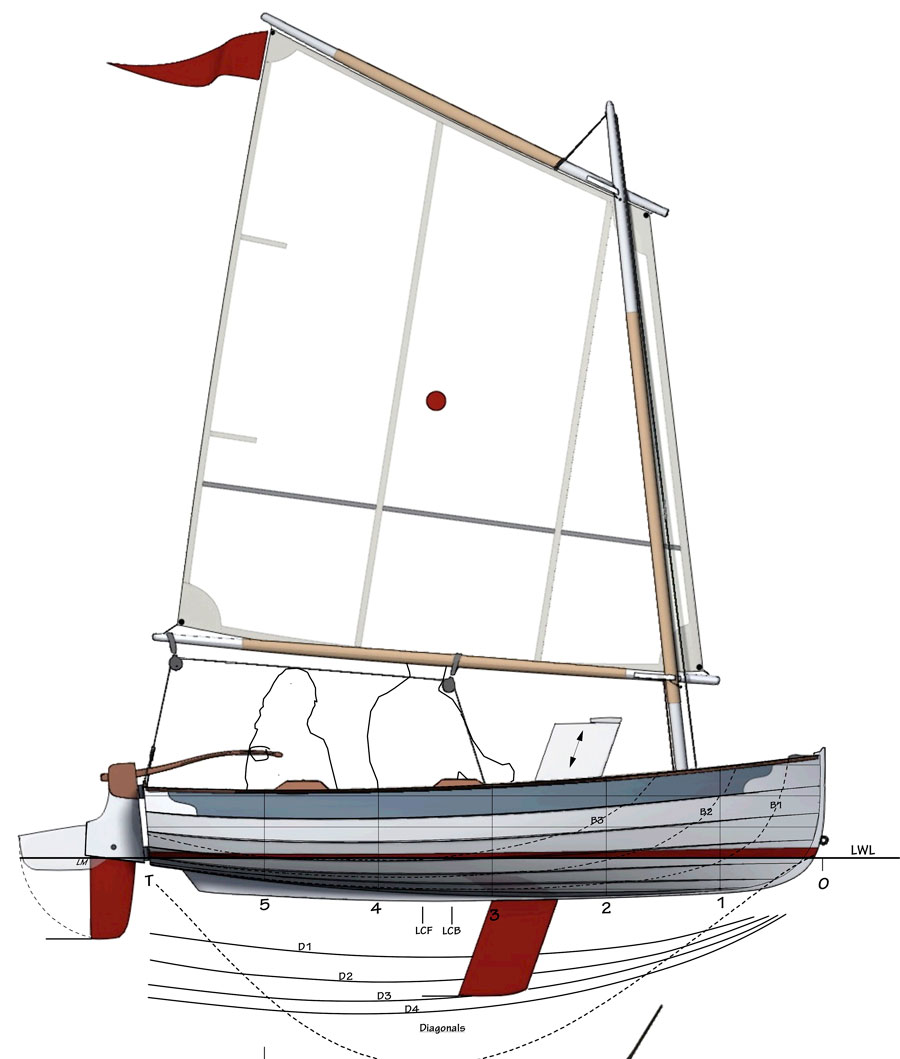 BelleHome Port: Orcas Island, WAYear Built: 2024LOA: 11'Beam: 4'6"Owner: Solianna HalabiskyDesigner: Laurie McGowenDesign: One-offType: Row
BelleHome Port: Orcas Island, WAYear Built: 2024LOA: 11'Beam: 4'6"Owner: Solianna HalabiskyDesigner: Laurie McGowenDesign: One-offType: RowBelle was designed by Laurie McGowan for the “sketchbook” section of Wooden Boat Magazine. She is a rowing-sailing dinghy 11- feet long made from local northwest woods and very little glue or plywood..
-
 BISHHome Port: Seattle, WAYear Built: 2022LOA: 34'8"Beam: 9'2"Owner: Karl BischoffDesigner: Murray PetersonDesign: SusanType: Schooner
BISHHome Port: Seattle, WAYear Built: 2022LOA: 34'8"Beam: 9'2"Owner: Karl BischoffDesigner: Murray PetersonDesign: SusanType: SchoonerBISH is a Murray Peterson Susan schooner. Port Orford Cedar on steam-bent white oak frames. Teak decks on laminated doug fir deck beams. Hand crank SABB lifeboat engine. All standing rigging is galvey 7×7, parcel and served. Built by Karl Bischoff in Georgetown, Seattle. It’s taken 12 years so far. For each task, I had to do research and take classes… NWSWB for stream bending, surveying, planking… Brion Toss’ loft for splicing/parcel/serving. BISH was my dad’s nickname. He was an armchair adventurer… always studying the Canadien Voyageurs, Wolves, Tugboat Captains of Oakland California, etc. He also loved to start organizations like the American Whitewater Association, American Canoe Association, Square-dance Callers of America, and American Spelunking Association (cave exploring). After living aboard my 37′ cutter for 8 years, I started my first build, a 15′ Whitehall named Leslie Jean (named for my lovely wife). So now there is BISH. I think I’ll name the dinghy Helen (my mom). It’s all in the family. Check out the whole build process at bischoffboatworks.com.
-
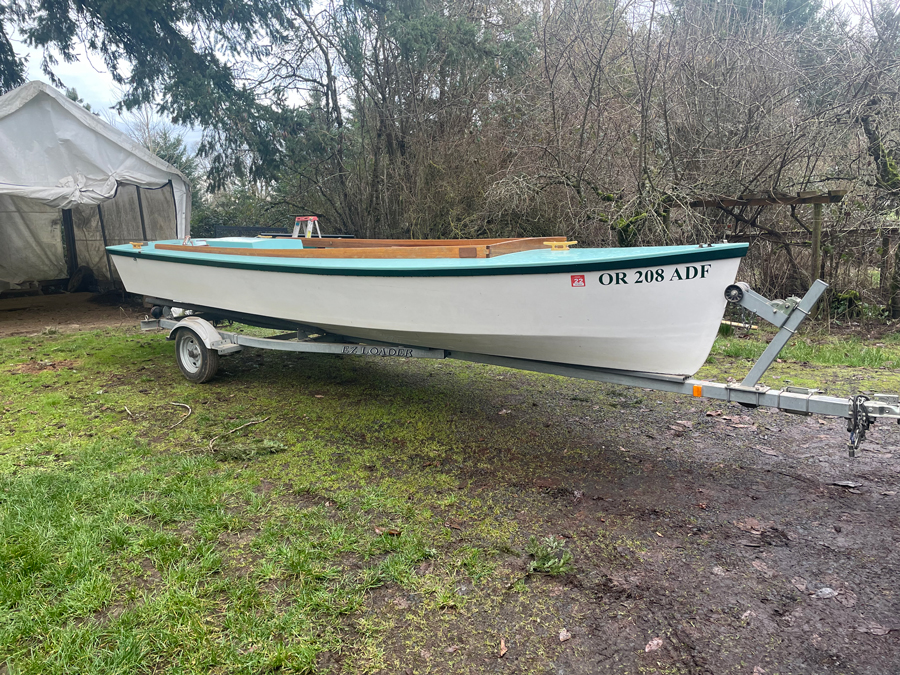 Black DogsFor SaleHome Port: Hillsboro, ORYear Built: 2007LOA: 22'6"Owner: Lark BrandtDesigner: William AtkinsDesign: Rescue MinorType: Power
Black DogsFor SaleHome Port: Hillsboro, ORYear Built: 2007LOA: 22'6"Owner: Lark BrandtDesigner: William AtkinsDesign: Rescue MinorType: PowerA Northwest built version of a William Atkins “Rescue Minor” Article by James Thomas from Small Craft Advisor Magazine
For some years I’d heard stories about a boat an acquaintance of mine, Mark Nelson, a skilled carpenter and machinist had built to allow his wife Lark and he to take day trips on the Rivers and Lakes in Oregon. Knowing my interest in all things boats, my friend Lynn Fox, suggested I contact Lark to see the boat. Mark passed away a couple of years ago, and Lark was interested in my opinion related to selling the boat; so I called Lark.
She said it was a Rescue Minor, designed in the 1940s by William Atkins as a shallow water boat for rescues and salvage work. My usual interest is sailboats, but the name of a famous designer piqued my interest so we made arrangements for me to visit her in rural Washington County, Oregon outside Hillsboro. We’d look at the boat, she’d share some notes Mark had made during it’s construction and then we’d head into Hillsboro for pizza, beer, and some local jazz.
So on a Tuesday afternoon I drove out to Lark’s place. She’d pulled the boat, named Black Dogs out of it’s shelter where it has sat since Mark’s death. I could see the appeal to Mark in the design. With a big open unobstructed hull, there was plenty of room for taking friends on picnics and with the unusual shallow draft stern design with the prop tucked up into the hull, the boat would be able to navigate the shallow waters of the Columbia River estuary islands with ease and could be camped on in a pinch. I’d seen pictures of versions of this boat gussied up with center console and varnished decks, but Mark’s was the real deal; a simple, elegant, tiller steered open boat with mahogany coaming, but workboat finishes otherwise. Lark shared Mark’s notes after he’d completed the build and we headed to Hillsboro for pizza and jazz.
It’s always sad when someone lavishes years and countless hours on building a boat they hope will become longtime part of the family and their hopes are cut short by an untimely death. Later, when I’d had a chance to look over Mark’s notes, I was especially struck by the thought and effort he put into creating the powerplant for the boat as well as to translating Atkin’s drawings into this boat. Mark was a consummate craftsman who created a truly unusual historic craft I felt was worth sharing with my fellow small craft lovers. In that spirit, I’ll let Mark’s description of his boat and it’s engine build conclude this article.
ENGINE CHOICE AND MODIFICATIONS
A significant amount of my time building the boat was dedicated to the engine build. The boat as Atkin designed it was originally powered by a 63 cubic inch Atomic Four engine. I converted a 1988 Chevrolet Sprint 61 cubic inch, 3 cylinder engine for powering the boat. This is identical to the Suzuki from which the Sprint was derived. The engine turns a 10” x 13” three blade propeller through a ZF-10 reverse gear with a 1.8 to 1 reduction. The carburetor is a single downdraft Solex carburetor from a Volvo Penta outdrive. A Seacamp heat exchanger provides for fresh water cooling for the aluminum block, head, and exhaust manifold. A Vetus muffler takes some the noise out of the exhaust, although it is louder than I had hoped when the engine is run at higher power settings. The raw water pump is from a Kohler generator set, and an ignition-protected Leece-Neville alternator provides charging current. The Sprint engine has more power than the hull requires, so the engine runs at fairly low throttle settings. Fuel consumption is typically under 1 gph. I have seen 18 mph on the GPS, but the boat throws a lot of spray at that speed and the engine is annoyingly loud. 10 to 12 mph is a more comfortable cruising speed. For the first season, I ran the engine without a cover. Adding the engine cover reduced noise a good deal. “USING BLACK DOGS:
“One of the pleasures of this boat is how easily and quietly it will slip along at about three knots. This is just right for keeping company with someone in a kayak or taking in the scenery in a backwater. The hull is so easily driven at low speeds that an electric motor could be an alternative if a limited range weren’t a problem.This is a much different boat than a modern 20 ft. fiberglass inboard designed to pull wakeboarders or go for a Sunday drinking party. The area under the foredeck holds the anchor, extra life vests and sand chairs. The 11 gallon fuel tank, spare parts, extra lines, etc. are under the stern deck. The battery and tools are under the bench seat. Current formal seating accommodates the pilot and two passengers, anybody else gets a folding chair.
There are any number of improvements that could be made, but at this point I am content to use it as a day boat on the rivers and lakes here in western Oregon. I chose to build the boat using plywood plank on frame because I was reasonably confident of a successful outcome since I was familiar with the method, but it could also have been executed in stitch and glue or using welded aluminum construction. A light removable top would give some protection from the summer sun and extend the cool weather boating season and removable bunk boards would let us sleep on the boat easier
-
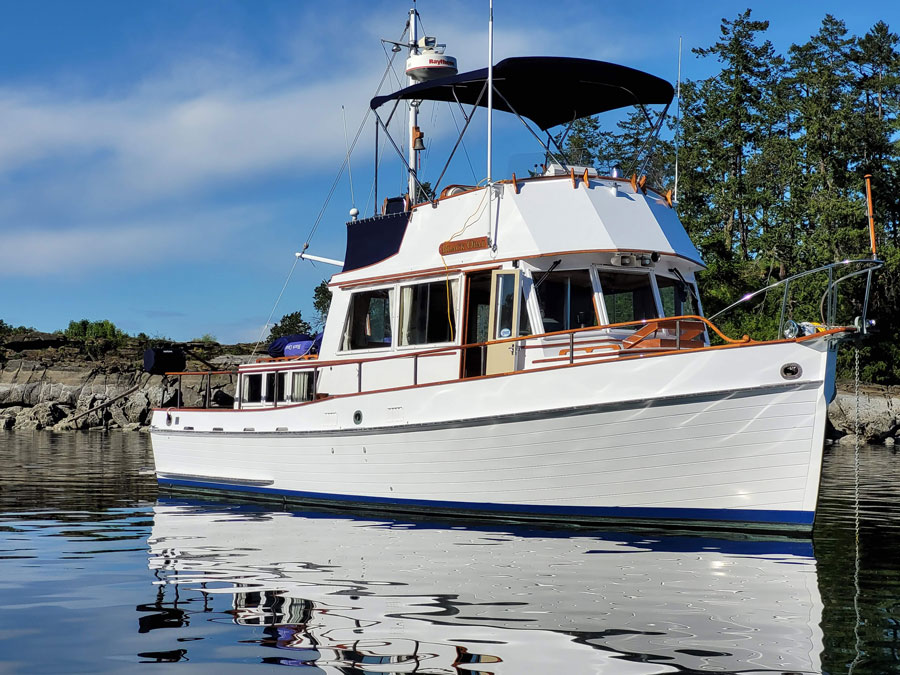 Black OpalHome Port: Bellingham, WAYear Built: 1973LOA: 38'6"Beam: 12'6"Owner: Ted BergDesigner: Kenneth SmithDesign: Grand Banks Classic 36'Type: Power
Black OpalHome Port: Bellingham, WAYear Built: 1973LOA: 38'6"Beam: 12'6"Owner: Ted BergDesigner: Kenneth SmithDesign: Grand Banks Classic 36'Type: PowerBuilt in 1973 by American Marine in Singapore, “Black Opal” is a rare 36’ Grand Banks Classic for a number of reasons. She’s one of the last GB woodies built, with the shipwrights using thick Philippine mahogany planks for the hull and old-growth teak on most of the topsides. Ever since Jim Thiele found her languishing down in Long Beach, CA in the 1990’s, she’s had a lot of TLC and always been under cover. Thiele did a major refurbishing over a four-year period that included the decks, the flybridge, new electronics, new fuel tanks, upgraded appliances, and much more. The Ford Lehman 120s even today only have about 3800 engine hours. When I purchased her from Jerry Norman in 2021, I put in new house/start AGM batteries, upgraded the refrigeration unit, added new radio equipment, including SSB (my call: W6TYZ). The rudder system has been repaired, with new mounting woods, linkages, packing glands, and bronze closing plates. Similarly the prop shafts have new packing glands and cutlass bearings. Engine upgrades and repairs have been made as needed. Finally, just this year, she received new varnish coats on the hand and cap rails, new hull paint, and fresh bottom paint. I think of “Black Opal” as one of the Northwest’s own historic boats, and that it’s my responsibility to keep her in the great condition she was in when turned over to my stewardship.
-
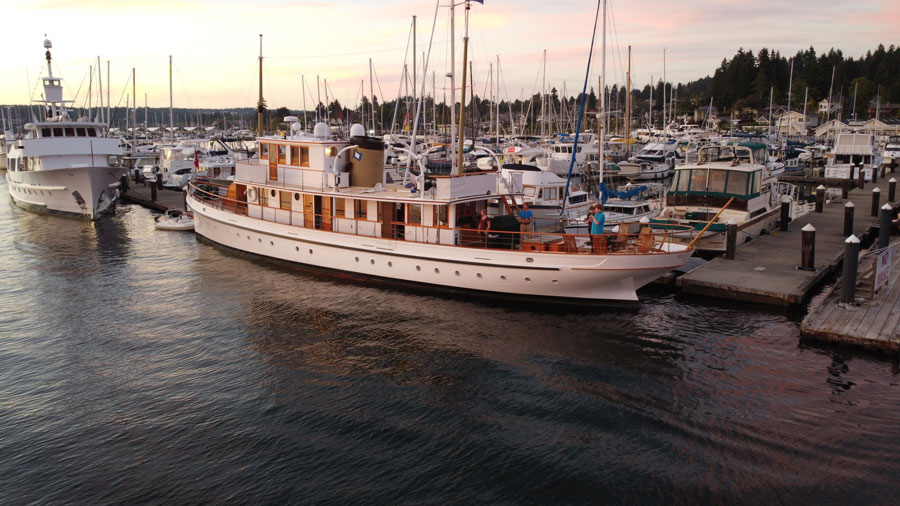 Blue PeterHome Port: Seattle, WAYear Built: 1928LOA: 96'Beam: 18' 6"Owner: Chuck and Linda BarboDesigner: Ted GearyDesign: One-offType: Power
Blue PeterHome Port: Seattle, WAYear Built: 1928LOA: 96'Beam: 18' 6"Owner: Chuck and Linda BarboDesigner: Ted GearyDesign: One-offType: PowerIn 1928, the Motor Yacht Blue Peter was built for the Seattle architect John Graham Sr. at Lake Union Dry Dock, and drawn by the famous local naval architect, Ted Geary. Four 96 foot fan-tails were built in the Seattle area during the same time, and there are several local “Cousins” active in Local waters today. The yacht has gone through several major refitting’s over the 95 years of her service, with the latest work done by Port Townsend’s own, Haven Boat works. She is constantly maintained by a small crew, and is works our local waters from Olympia northward. Normally in private service, Blue Peter has recently begun offering charters for up to eight overnight guests and up to 12 guests for daytrips. Wedding parties, dinner and wine-tasting, as well as local cruising is available with limited schedules.
-
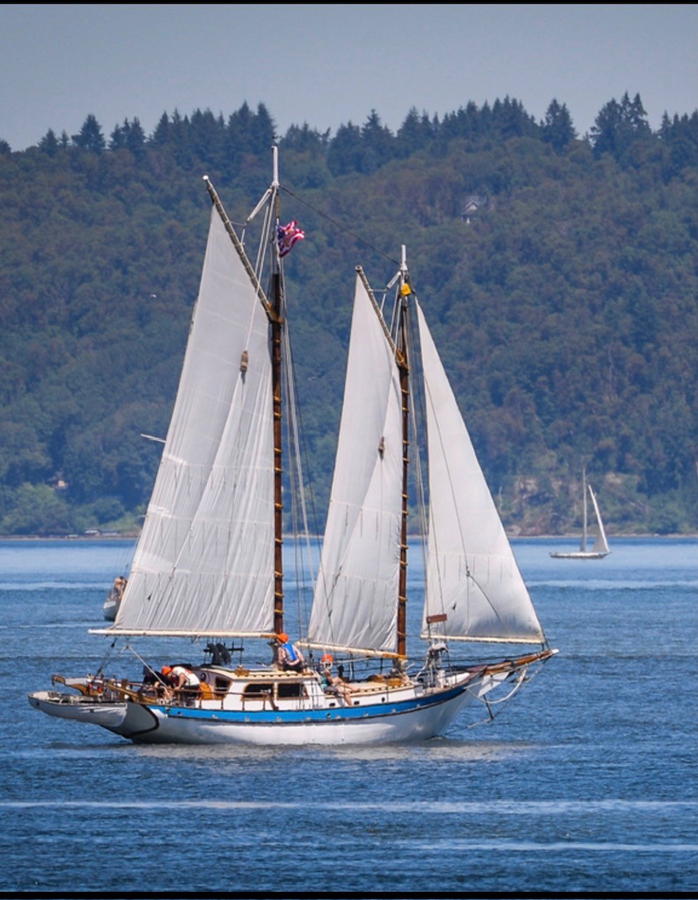 Blue StarrHome Port: Seattle, WAYear Built: 2005LOA: 50'Beam: 12'Owner: Alex JonesDesigner: Bill GardenDesign: One-offType: Schooner
Blue StarrHome Port: Seattle, WAYear Built: 2005LOA: 50'Beam: 12'Owner: Alex JonesDesigner: Bill GardenDesign: One-offType: SchoonerLaid up in 1970, launched in 2005, two brothers working at the Nanoose Shipyards in Nanaimo (Vancouver Island) built Blue Starr with Bill Garden’s blessing. Garden, who lived on Toad’s Landing – his personal island not far away from Nanaimo, may have even asked the brothers personally to finish out their Alaskan Yellow Cedar on Oak “Walloon” hull as a Schooner, as he had decided the lines would be better suited as a Schooner rather than the 89 Walloon Ketches that had been built around the world. Either way, his signature rests on the modified draft designs onboard, where the cabin and rigging were modified before construction. Unfortunately, shortly after launch in Port Alberni (yes, a conundrum as to why she was launched on the other side of the island), one of the brother’s passed away and the boat was donated to SALTS in Victoria BC, where it was eventually bought by Rayford Chew, who now owns Schooner Tyrone in Maine. Captain Alex bought her in early 2022, and has been living aboard and refitting her while charting future courses beyond Cape Flattery.
-
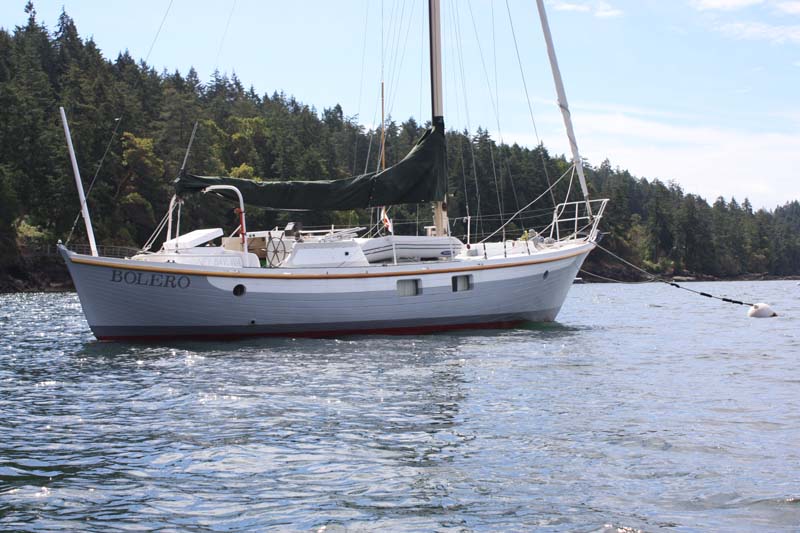 BoleroFor SaleHome Port: Bremerton, WAYear Built: 1965LOA: 40'Beam: 10'6"Owner: Jay SpearmanDesigner: Bill GardenDesign: One-offType: Sloop
BoleroFor SaleHome Port: Bremerton, WAYear Built: 1965LOA: 40'Beam: 10'6"Owner: Jay SpearmanDesigner: Bill GardenDesign: One-offType: SloopBolero is an original double-ended 40 foot sloop designed by the renowned N.A. Bill Garden and launched in 1965. Her distinctive appearance, clean lines, flush deck, and raking jack staff present a strong statement. She has been featured in numerous books and magazine articles.
Bolero was always one of Bill Garden’s favorites. He made many trips aboard her, with his close friend and builder/shipwright, Jim Hillman. Built as a potential live-aboard for Jim, she has a double cabin, with generous headroom throughout the main cabin. As an early design with port lights in the hull, it is possible to sit at the dinette and view the harbor from opened ports and deck hatches. She is of traditional Northwest construction. Hull material is Alaska Yellow Cedar with oak ribs. Deck is 2 layers of plywood overlaid with fiberglass. Mast is Sitka spruce. She sails well and sports new sails. A classic Puget Sound cruising boat that has sailed the waters of the Salish Sea, northern British Columbia, and has been as far north as Ketchikan, Alaska. Possibly beyond.
-
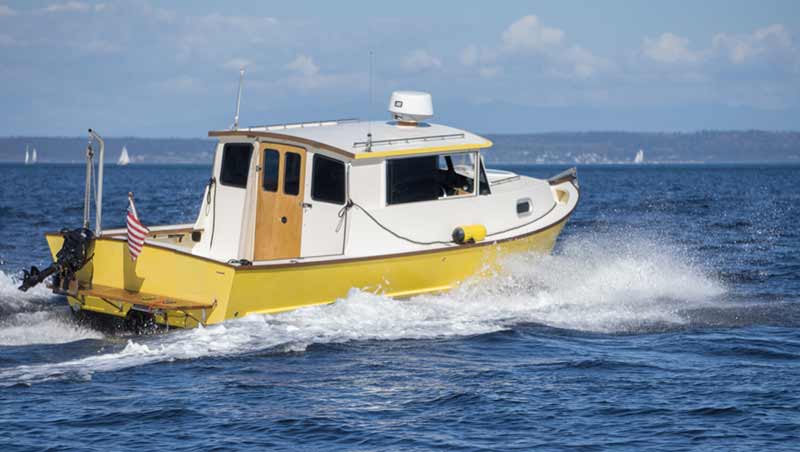 Bright StarHome Port: Lake Oswego, ORYear Built: 2004–2006LOA: 27'Beam: 8'Owner: Ray BrownDesigner: Renn TolmanDesign: Tolman Alaskan Skiff Jumbo 24Type: Power
Bright StarHome Port: Lake Oswego, ORYear Built: 2004–2006LOA: 27'Beam: 8'Owner: Ray BrownDesigner: Renn TolmanDesign: Tolman Alaskan Skiff Jumbo 24Type: Power“Bright Star” is a Tolman Jumbo 24, from a design by Renn Tolman of Homer, Alaska. As are all the Tolman boats, she is a plywood stitch-and-glue wooden boat, and light for her size.
The Tolman Alaskan Skiffs began as 18′ open boats, built for fishing in Alaskan waters. The basic design has evolved. Most now are cabin boats 22′-24′ long, with a few built at 26′, and built by the people who plan to use them.
Ray built her on our backporch. It took 2.5 years, from delivery of plywood to launching. We customized ours as a cabin cruiser, for cruising and fishing. Recently, we switched from a chemical toilet to a composting one, and are well-pleased at how it works. Two sleep and live comfortably on Bright Star, and last year we created a bed space for a family member to join us. It worked very well.
The boat is powered by a Cummins diesel MerCruiser 1.7L, 120hp, inboard/outboard. Cruising speed is 18 mph and cruising weight, fully provisioned and stowed, is 3800 pounds. Being light for its size, Bright Star is easy to tow. We use a Dodge Ram diesel 4-door pickup.
This boat gets great fuel economy. With two 36-gallon tanks, we have a range of 300 miles, at speed. So far, we have 7900+ statute miles under our keel. Note: This is at WBF appplication time. More cruising happens in the 2023 season.
Local home area day trips and cruising have been in the Willamette and Columbia Rivers. But most of our cruising has been up north, in salt water. Having a trailerable boat allows us freedom easily to go farther, and get into salt water in Washington and BC. As former long distance offshore sailboat cruisers, we find it great fun to get to places faster, and have more time for fishing, exploring, and in ports for seeing the smaller communities.
We’ve explored the South Sound, spent a lot of time inside, along Vancouver Island, in the San Juans, more time in the Gulf Islands, went up the Fraser River, and north on the BC mainland side. We cruised in the Broughton Archipelago, taking the ferry Coho over to Victoria and driving up to Port McNeill to launch. An outside trip from Port Townsend to Walters Cove, almost to Brooks Peninsula, taught us that when the fishing boats are filling the harbor in Tofino, we should stay put. Ask us how we know this boat can fly.
Cruising was put on hold during 2020 and 2021. With more time at home, Ray began building another boat. Based on a Tolman hull design, it is a 21′ open speedboat, modified to be all-electric, with solar panels and Tesla batteries, built for use on a lake.
More information on the building of cabin boat Bright Star — www.backporchboat.org/
— Ray Brown
-
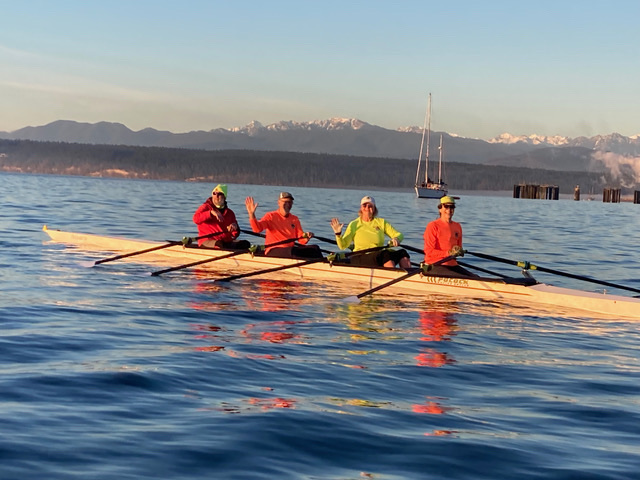 BuckleyHome Port: Port Townsend, WAYear Built: 1960'sLOA: 30'Owner: Rat Island Rowing Club Sally GieslerDesigner: George PocockDesign: 4x quad rowing shellType: Row
BuckleyHome Port: Port Townsend, WAYear Built: 1960'sLOA: 30'Owner: Rat Island Rowing Club Sally GieslerDesigner: George PocockDesign: 4x quad rowing shellType: RowThis boat was built by George Pocock and his son Stan in the early 1960’s for Ervine Valley College, CA. It was originally called the John Lusk while at the school. John was a reality broker in Los Angeles then and had given a large donation while his son went to the school.
The Rat Island club acquired the boat in early January 2023 and a group of committed rowers worked on the restoration winter thru summer. Got it done in time for the Wooden Boat festival. -
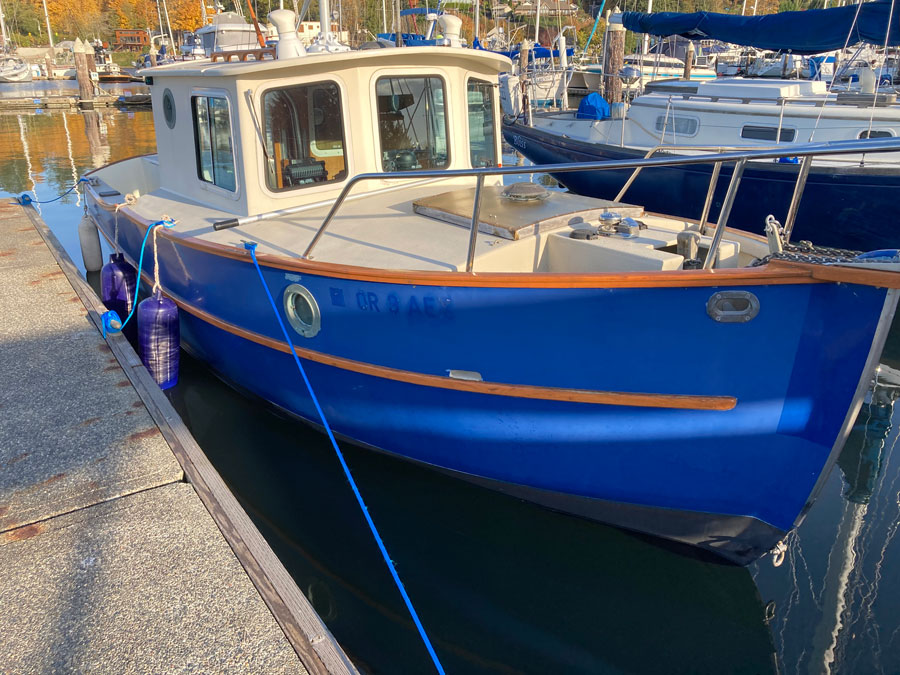 Burns CovweHome Port: Olympia, WAYear Built: 1989LOA: 22'4"Beam: 8'4"Owner: Stet PalmerDesigner: Sam DevlinDesign: Surf ScoterType: Power
Burns CovweHome Port: Olympia, WAYear Built: 1989LOA: 22'4"Beam: 8'4"Owner: Stet PalmerDesigner: Sam DevlinDesign: Surf ScoterType: PowerThis 1989 Sam Devlin designed and built Surf Scoter was built with an in hull outboard engine. The boat has had about four owners and after being brought out of long term pandemic storage the new owner turned this tough little boati over to Makenzie Devlin for a winter renewal project.. We feel the boat is ready now for the next 35 years of traveling the Salish Sea from north to south. There is one unusual change a pervious owner made to the original design and that is a bow thruster! On this short boat that makes one person docking somewhat easier.
-
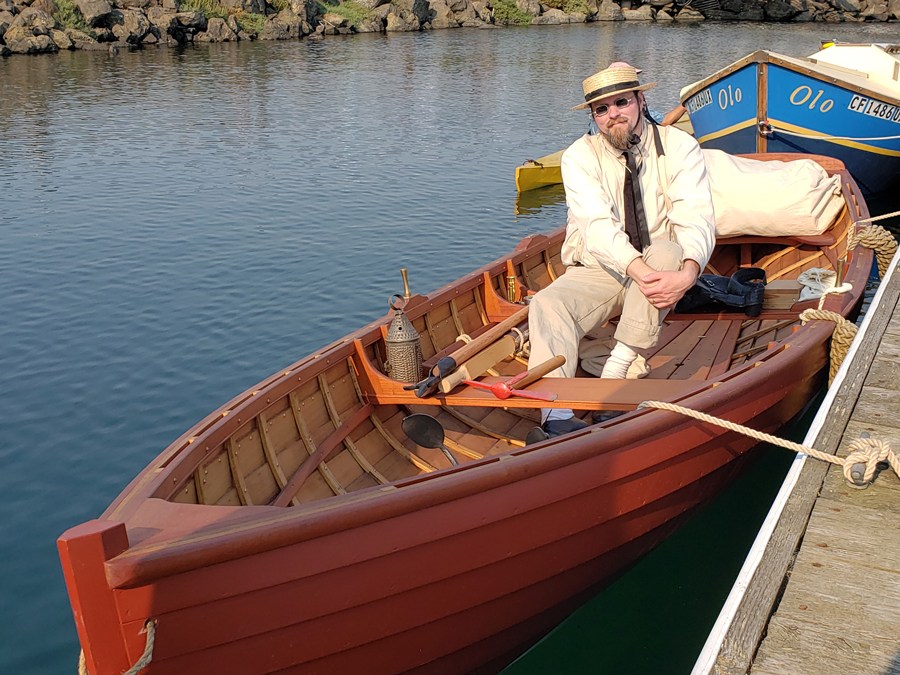 BuʔqʷHome Port: Olympia, WAYear Built: 2022LOA: 17'Beam: 5'Owner: Michael BuseDesigner: Tim Lee, John Gardner, SmithsonianDesign: One-offType: Row
BuʔqʷHome Port: Olympia, WAYear Built: 2022LOA: 17'Beam: 5'Owner: Michael BuseDesigner: Tim Lee, John Gardner, SmithsonianDesign: One-offType: RowBuʔqʷ, pronounced approximately like ‘poke’ but with a ‘b,’ which is Lushootseed for duck (as in the bird), is a 16 foot replica ship’s small boat from the 19th Century. She is a replica of what I believe was the smallest ship’s boat carried by the USS Massachusetts in April of 1850, when the Massachusetts became the first American, and the first propeller driven, steamship on the waters of the Salish Sea. Through Buʔqʷ I will tell the story of the Massachusetts and her crew. Why should people today care? Ultimately it was American steamers that influenced the Salish Sea the most, and the screw propeller proved to be the most effective way of transmitting the power of an engine to the water…look at Point Hudson, Boat Haven, Port Townsend Bay or Admiralty Inlet…almost all of the vessels you see have screw propellers today. Steamboats facilitated travel and commerce, encouraging settlement of non-Indigenous peoples, but they also aided in the destruction of the environment and the way of life of Native Americans. Although my project focuses on the Massachusetts, Buʔqʷ can play many roles and is not merely a boat…she is a time machine. She can slip back to the 1790s and accompany Vancouver, she could have been carried by a fur trading vessel in the early 19th Century like the Guatimozin (which may have been the first non-Indigenous American ship on the Salish Sea), she could have been carried in 1841 by the US Exploring Expedition under Charles Wilkes, she could have been used by the Hudson’s Bay Company, she could have been tied up in a creek to help people get around the Sound, and she is also a great boat in the present. I would like to make folks who attend the Port Townsend Wooden Boat Festival aware of this incredible and influential history that few people know about today. Thank you.
-
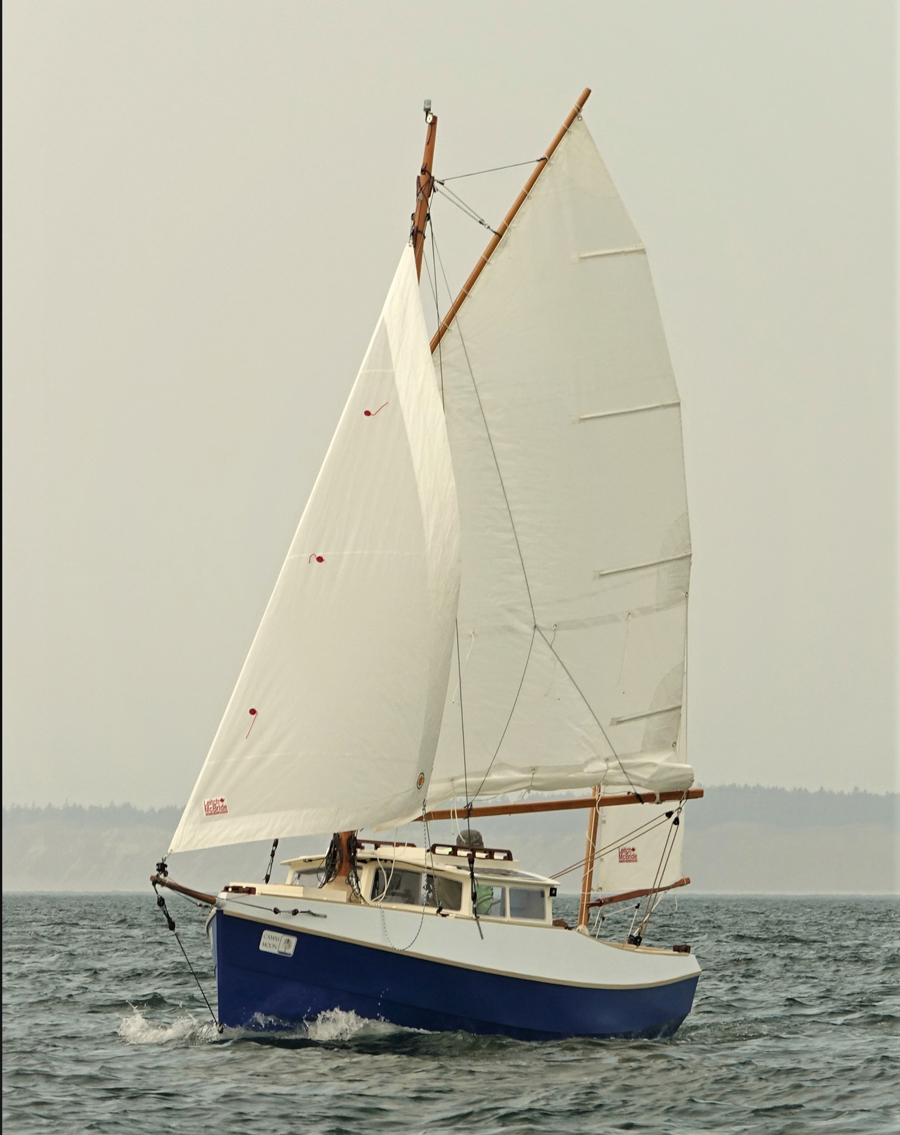 Camas MoonHome Port: Victoria, B.C.Year Built: 2022LOA: 24'Beam: 6'6"Owner: Alex ZimmermanDesigner: Tad RobertsDesign: CoPogy 18Type: Yawl
Camas MoonHome Port: Victoria, B.C.Year Built: 2022LOA: 24'Beam: 6'6"Owner: Alex ZimmermanDesigner: Tad RobertsDesign: CoPogy 18Type: YawlCamas Moon is the first boat built to Tad Roberts’ new CoPogy 18 design. She is 18’ LOD, 24’ LOA, 6’6” beam, and 9” draft. She is rigged as a gaff yawl, with an off-center pivoting centerboard, and has a 6 HP outboard motor in a well. Designed as a trailerable mini-motorsailer for one or two people, she will be equally at home motoring all day in the calms or sailing when the wind serves. Construction is stitch-and-glue around structural ply bulkheads, hull and deck is marine ply, with Douglas Fir for most other elements, including the spars. Extensive watertight storage compartments make the boat unsinkable. Construction began not long after the start of the pandemic and was completed in June 2022.
-
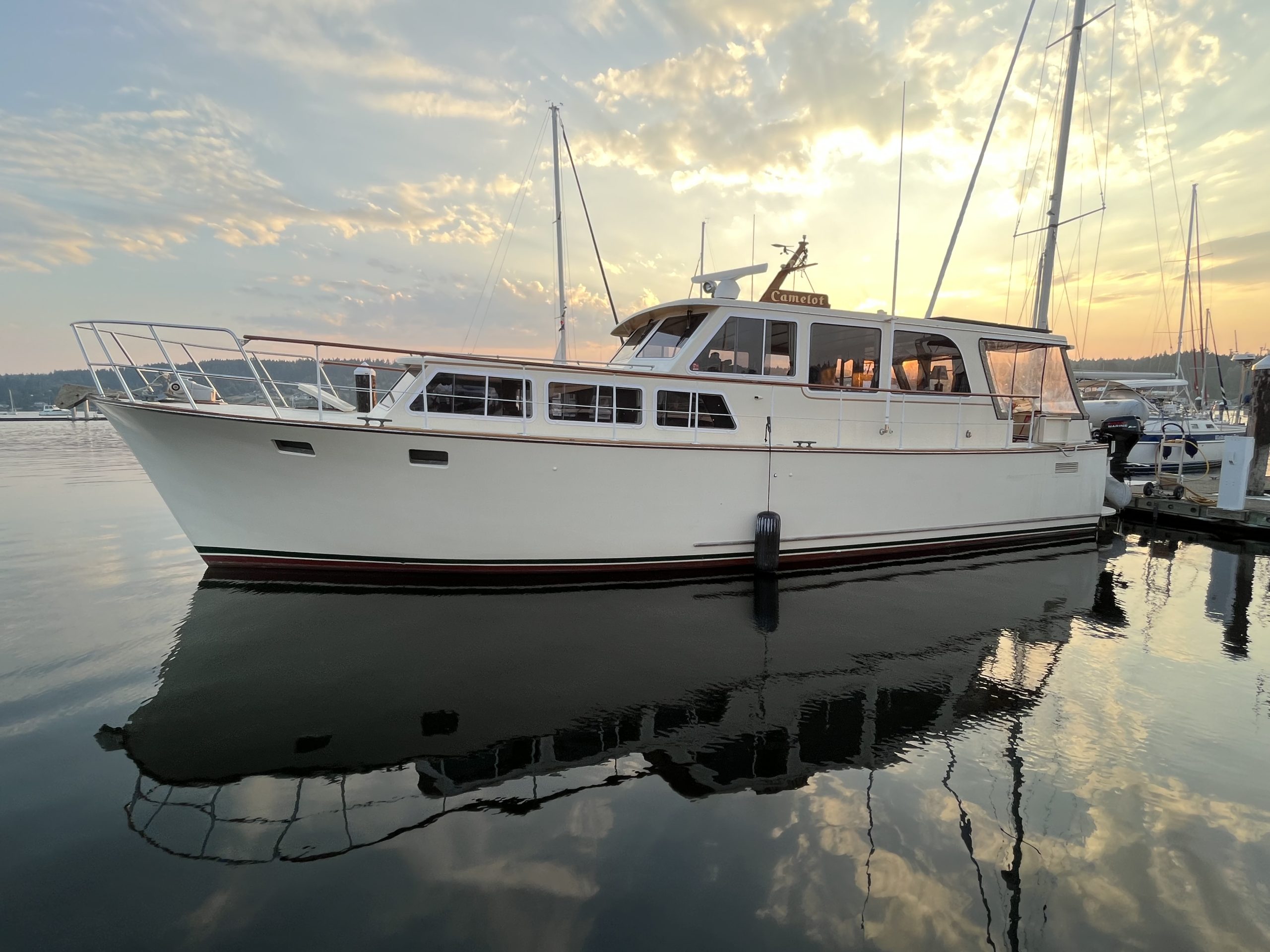 CamelotHome Port: Port Orchard, WAYear Built: 1968LOA: 44'Beam: 14'5"Owner: Lucie MewesDesigner: Ed Monk SrDesign: SedanType: Power
CamelotHome Port: Port Orchard, WAYear Built: 1968LOA: 44'Beam: 14'5"Owner: Lucie MewesDesigner: Ed Monk SrDesign: SedanType: PowerCamelot was designed by Ed Monk Sr and built by Taylor Boat Company, Seattle. she is a sedan-style cruiser built on a semi-displacement hull constructed from quality boat lumber. Her carvel planked cedar hull is bronze fastened on bent oak frames. Hull material is red and yellow 1 1/8’ cedar. Keel is Douglas fir. Framing is white oak 2” x 1 ¾”. Decks are plywood over 1 x 3” 16” centers. Superstructure is plywood with fiberglass overlay.
Camelot is powered by her original twin 130 HP Perkins 6-354 diesel engines and Walter V-drive. She measures 44’x14’3” and draws 3’6”. GRT is 31; net 22.
Little is known about her owners prior to 1998. In 2004 the Morgan family of Renton WA bought Camelot in Friday Harbor WA for family cruising. Camelot underwent a complete refit in Port Townsend, including framing and planks, and upgrading the electrical, electronic and sanitation systems. Diamond Seaglaze windows were installed. Her Salon and Cockpit were redesigned and new upholstery and draperies were installed throughout.
